IN THIS REPORT
- September at a Glance
- Vital Trends
- Key Developments
- Monthly Focus: Multiple Coinciding Conflicts and Ethiopia’s Rank in the ACLED Conflict Index
September at a Glance
VITAL TRENDS
- In September, ACLED records 158 political violence events and 454 reported fatalities in Ethiopia.
- Most of the political violence was recorded in Amhara region, where Fano militias and government forces have been clashing since April. The second highest number of political violence events was recorded in Oromia region, with 41 events and 66 reported fatalities. Violence targeting civilians accounted for 36% of fatalities, while other violence included clashes between government forces and the Oromo Liberation Front (OLF)-Shane and Fano militias.
- In September, the most common event types were battles, with 94 events recorded, and violence against civilians, with 47 events recorded. Last month, recorded incidents of political violence decreased throughout the country.
KEY DEVELOPMENTS
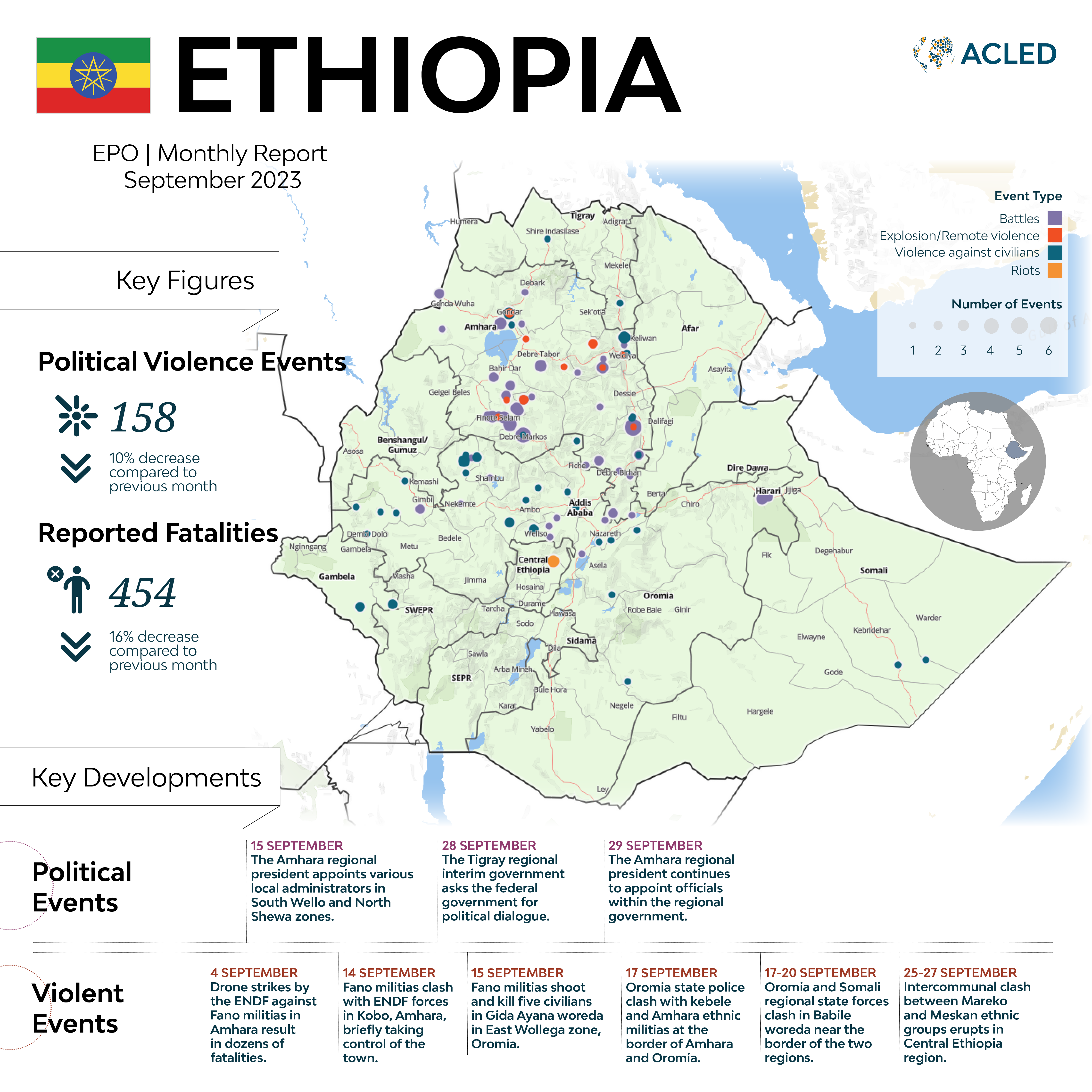
Monthly Focus: Multiple Coinciding Conflicts and Ethiopia’s Rank in the ACLED Conflict Index
Ethiopia ranked 25th highest globally on the latest version of the ACLED Conflict Index, which recently published a mid-year update assessing data from July 2022 to July 2023. The Index, initially released in January 2023, ranks countries according to levels of political violence, assessing four key indicators – deadliness, danger to civilians, geographic diffusion of conflict, and the number of active non-state groups (or fragmentation). The top 50 countries listed in the Index account for 97% of all political violence events recorded in ACLED’s database from July 2022 to July 2023. Ethiopia’s ranking in the Index also categorizes it as a country with ‘high’ level of conflict. Notably, Ethiopia’s rankings regarding deadliness and danger to civilians indicators are higher than the global average, while its rankings on the geographic diffusion of conflict and fragmentation are comparatively low (see graph below).
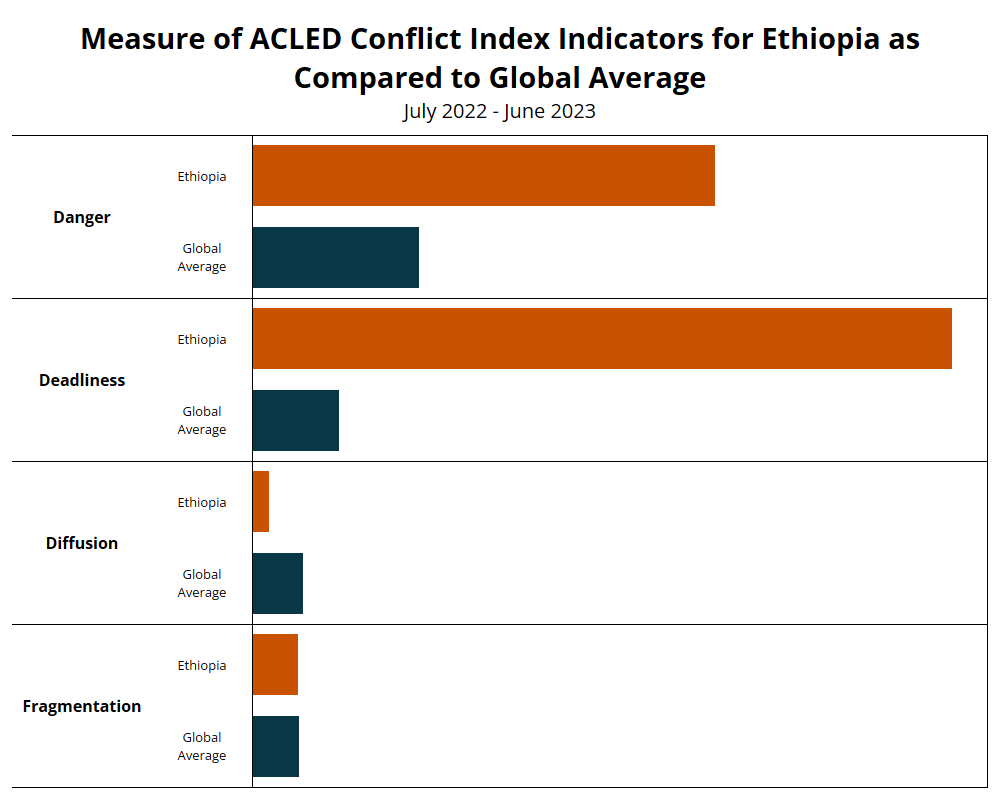
Given these findings from ACLED’s Conflict Index, this report explores specific aspects of Ethiopia’s conflict dynamics going beyond the scope of the Index to provide context and analyze developments as recently as 30 September 2023. Through examining the key features of Ethiopia’s conflict landscape and level, this report concludes that even if there is a high level of conflict, and Ethiopia’s political conflict is deadly, the government will likely remain in power due to the fragmentation of non-state armed groups.
Complex Layers of Political Competition
During the period assessed by the Conflict Index – from July 2022 to July 2023 – battles are the most frequently recorded type of political violence, followed by violence against civilians (see figure below). At least 4,805 reported fatalities are estimated to have occurred as a direct result of political violence in Ethiopia during the period covered by the Index, placing the country in the ‘high’ category for deadliness. The ethno-federalist political system of Ethiopia incentivizes political competition between ethnic groups, and as a result fuels ethnic conflict. This dynamic places civilians at particular risk, as populations are perceived as being involved in conflicts based on their ethnic affiliations. Thus, violence against civilians is a key feature of conflict in Ethiopia, accounting for 41% of all violence recorded in the country.
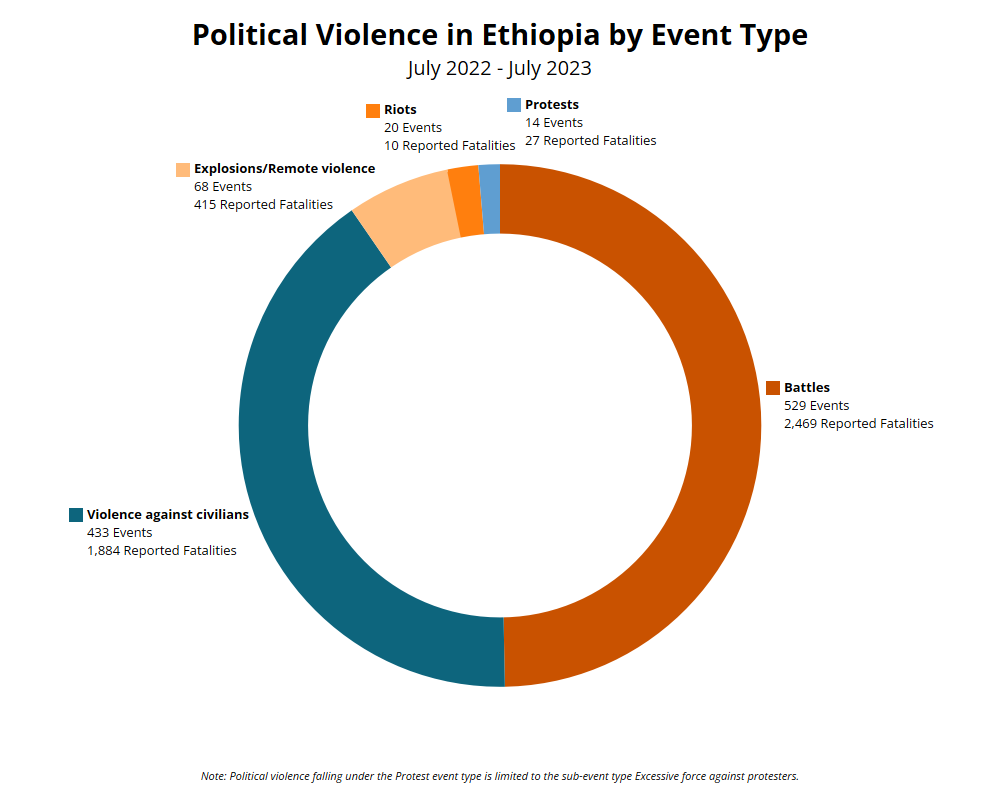
Ethiopia’s conflicts wax and wane in sync with political developments in the country. The most peaceful period in Ethiopia since the beginning of the northern Ethiopia conflict in 2020 was the months following the signing of a peace deal between the federal government and the Tigray People’s Liberation Front (TPLF) in November 2022. However, violence rose again as conflict in Amhara region broke out in August 2023 following a decision by the federal government to dissolve the country’s special forces (for more, see EPO Monthly: August 2023 and EPO Weekly: 29 July-4 August 2023). Moreover, an intense return of violence to Oromia region followed a failed attempt at peace talks with the Oromo Liberation Army (OLA) – also known as the OLF-Shane – in May 2023 (for more, see EPO Monthly: May 2023).
Another key feature of the violence in Ethiopia is the multiple coinciding but unrelated conflicts that are ongoing in the country at any given time. Multiple non-state armed groups challenge Ethiopia’s security forces across many locations in the country, representing a fragmented and complicated governance environment. Some of these non-state armed groups want to remove the government from power; others want to establish their own administrative levels like a zone or region. While weak coordination among different opposition and insurgency groups does occur among Ethiopia’s anti-government groups – for example, the United Front of Ethiopian Federalist and Confederalist Forces – they generally act independently. This, among other reasons, is why Ethiopia scored lower under the fragmentation indicator. This indicator looks at the fragmentation of non-state actors as a singular consolidated armed group can be a serious challenge to governments. On the contrary, a highly fragmented environment makes it difficult to engage the necessary actors in effective negotiations and may indicate multiple overlapping conflicts that are more challenging to resolve simultaneously. The separate peace talks between the government and TPLF in November 2022 and the government and OLF-Shane/OLA are good examples of this dynamic. Though TPLF and OLF-Shane/OLA announced their alliance against the government in August 2021 during the northern Ethiopia conflict,1Al Jazeera, ‘Ethiopia armed group says it has alliance with Tigray forces,’ 11 August 2021 peace talks with the government were held separately. The peace talk between the government and TPLF was concluded with a peace agreement in November 2022, while the first round of talks with OLF-Shane/OLA ended without an agreement in May 2023.
Furthermore, political restructurings – especially concerning demands for ethnic autonomy, such as those that result in a change in administrative boundaries or levels – often result in high levels of violence (for more, see the EPO’s Konso and Segen Area People’s Zones Conflict, and the Wolayta Conflict pages). For instance, the restructuring of the Southern Nations, Nationalities and Peoples region has created tension in Gurage zone, which wanted to establish its own regional administration (for more, see the EPO Monthly: July 2022). In September 2023, another round of intercommunal clash erupted in Meskan and Mareko woredas, which used to be under Gurage zone. For the past two decades, there has been a dispute between the two ethnic groups over the ownership of nine kebeles in Meskan woreda. When the Central Ethiopia region was established, it was decided that Mareko woreda would be a special woreda while Meskan woreda joined with Butajira town to become East Gurage zone (for more, see EPO Weekly: 30 September-6 October 2023).
As the government works to subdue one conflict, others have erupted throughout the country Subsequently, Ethiopia is likely to continue ranking as one of the high-level of conflict-affected countries, given the multiple ongoing conflicts that have yet to be solved.
Scattered Nodes of Political Violence
Ethiopia stands out among other countries in the high category due to the dynamic nature of the conflicts that contribute to its placement in the top 50. The multiple coinciding conflicts are not limited to a specific geographic area or type, presenting a unique challenge. Since Abiy Ahmed became prime minister in 2018, conflict in Ethiopia has been consistently high, although disorder has shifted geographically throughout various parts of the country over time (see graph below). In 2018 and 2019, riots and protests in Oromia region and ethnic violence in the country’s south were frequent. Battles and violence against civilians in Oromia region rose throughout the latter half of 2021 and into the first half of 2022, peaking in November 2022 (for more, see the EPO Monthly: November 2022). Armed clashes between federal troops and forces of the TPLF in Tigray region in the country’s north began in November 2020, expanded to Amhara and Afar region in July 2021 and continued until November 2022.
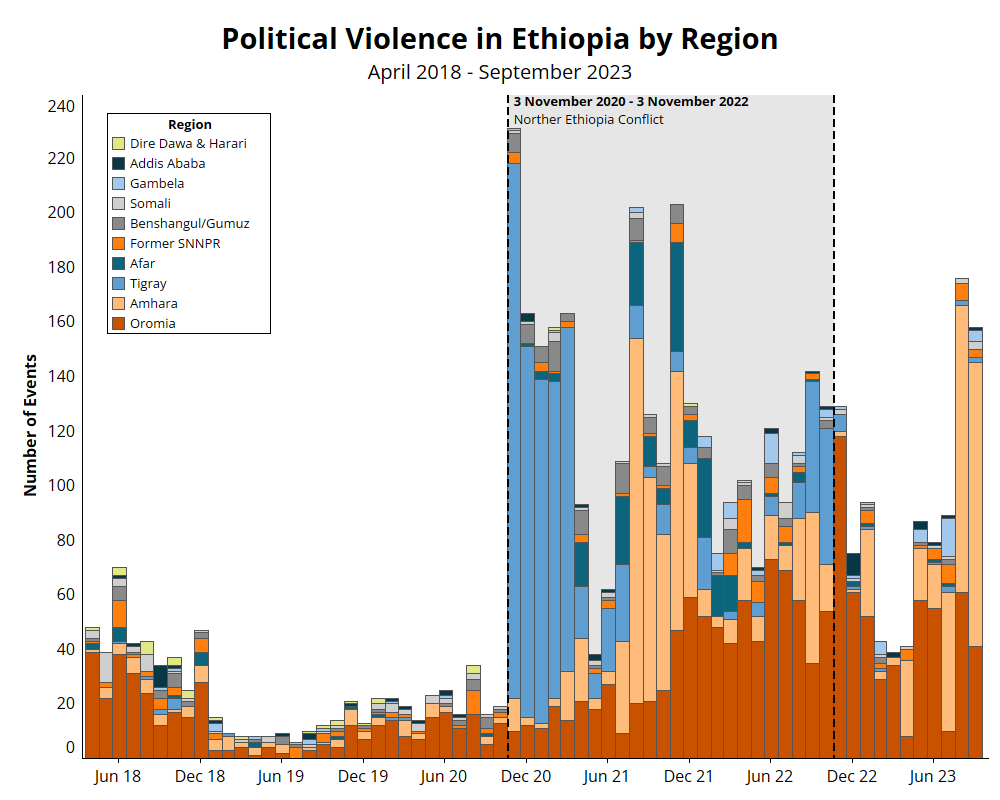
Over the past 12 months, following the end of the northern Ethiopia conflict with a peace treaty signed in November of 2022, violence in Ethiopia trended downwards. February and April 2023 recorded the lowest levels of political violence since the start of the northern Ethiopia conflict in 2020. In May 2023, violence returned to higher levels due to a return of conflict in Oromia region despite attempted peace talks between the federal government and OLA/OLF-Shane. In July 2023, while conflict was declining again in Oromia region, armed clashes between Fano militias and the Ethiopian National Defense Force (ENDF) swept across Amhara region, returning the country to high levels of political violence once again.
Other conflicts throughout the country took a backseat as the Amhara regional government and federal authorities attempted to defeat Fano militias. Amhara region had the most political violence events of any region in April 2023, and then from July to September 2023 since the northern Ethiopia conflict moved into Amhara region in July 2021. ACLED records the second highest number of political violence in Oromia region in September, although lower than in previous months. In addition to these two regions, certain areas in Ethiopia have been consistently experiencing instability over the past two years. These include Metekel zone of Benshangul/Gumuz region, North Western zone of Tigray region, and Agnuwak zone of Gambela region. These smaller geographic areas that have been consistently violent also contribute significantly toward Ethiopia’s place in the index.
Worrying Signs of Escalation with Challenges on Multiple Fronts
While the Index assesses the conflict has been consistently high, since August 2023, conflict in Ethiopia appears to be worsening once again (see graph below). The prospects for peace talks that appeared bright in the spring of 2023 are rapidly dimming, as conflict returns without a peace agreement (for more information on recent rounds of peace talks, see EPO Monthly: March 2023). The national peace dialogue process does not appear to be affecting the trajectory of conflict within the country, as the National Dialogue Commission has been slow and is still in the process of selecting participants and collecting the dialogue agenda.2Tegbaru Yareda, ‘Ethiopia’s National Dialogue needs greater credibility and inclusivity,’ Institute for Security Studies (ISS), 20 September 2023 The National Dialogue Commission was established in December 2021 to facilitate inclusive dialogue and reconciliation processes among various stakeholders with the hopes of establishing sustainable peace in the country.3Deutsche Welle, ‘Ethiopia to create national dialogue commission,’ 30 December 2021
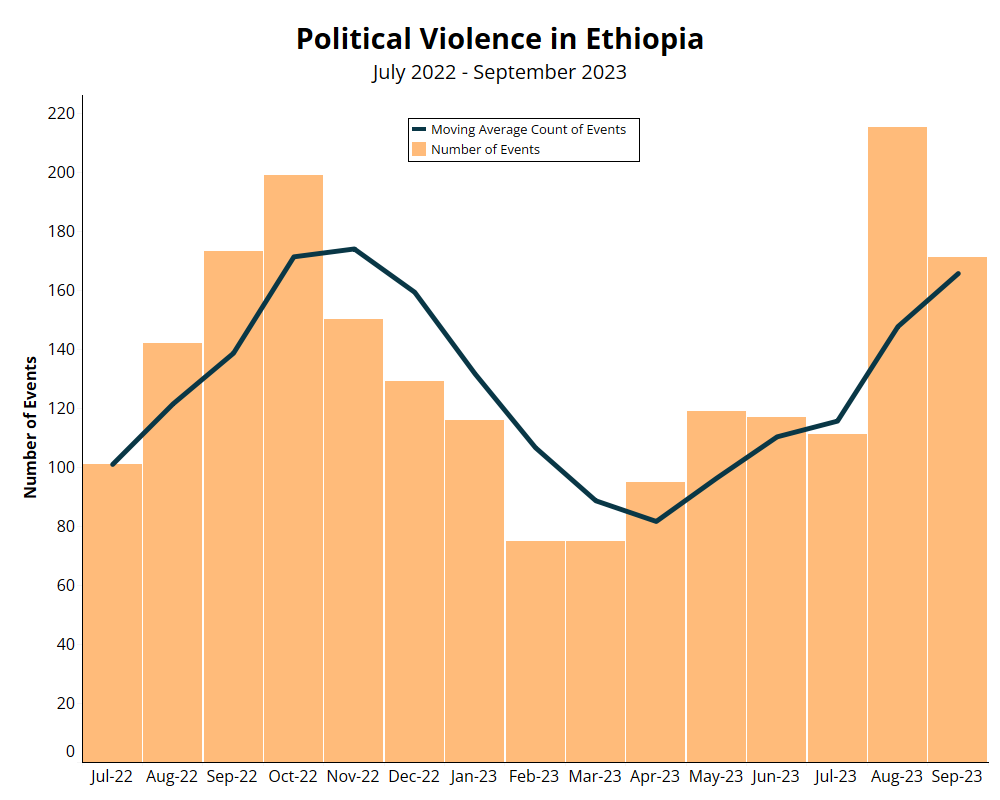
Additional worrying signals were observed throughout the country in September. The most recent rise in violence is attributed largely to violence in Amhara region, although, as explained below, there are indications that wider violence could return to other parts of the country.
Amhara region currently faces a challenging situation, as shown by the state of emergency declared on 4 August 2023. Over the past month, there have been reports of shelling, airstrikes, and battles in multiple cities and towns across the region. Efforts to restructure the Amhara regional government are unlikely to effectively address the ongoing violence in the region. Despite the appointment of a new regional president and other officials since August 2023, aimed at enhancing governance capacity, conflict has persisted in the region (for more on these reforms, see EPO Monthly: August 2023 and EPO Weekly: 2-8 September 2023). In September alone, ACLED records 77 battle events and 14 incidents of violence targeting civilians (see map below).
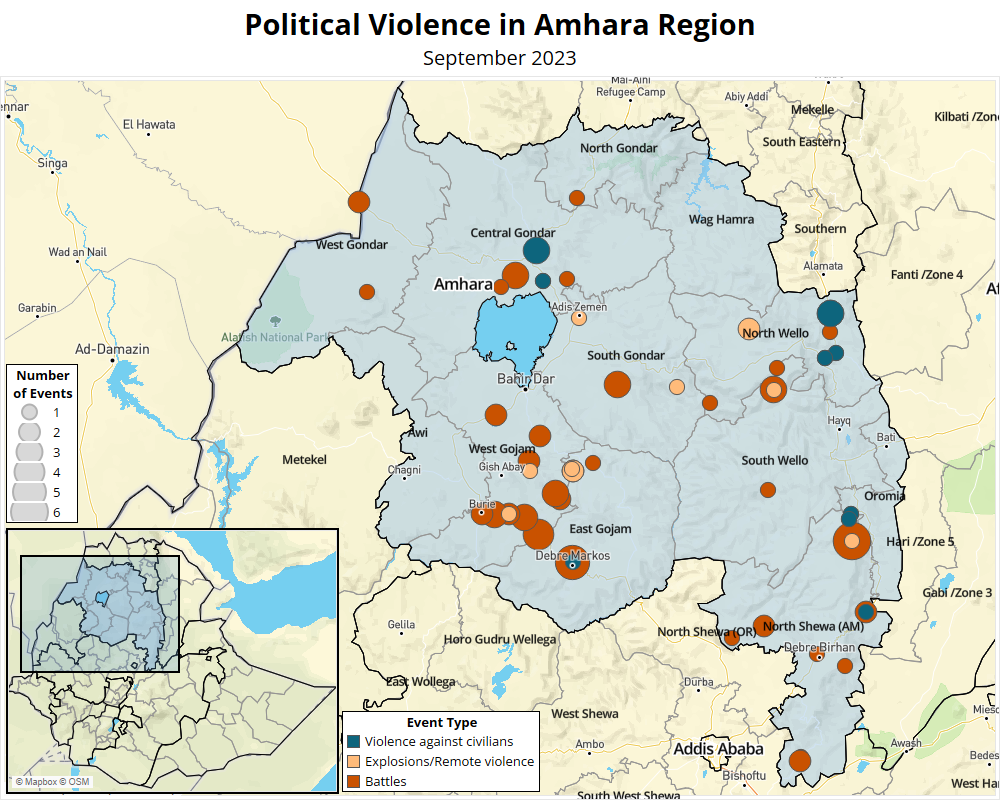
In Tigray region, which has seen little violence since the signing of a peace deal in November 2022, protesters denouncing the regional government were violently dispersed in September. The protest was organized by three opposition parties – Salsay Weyane Tigray, National Congress of Greater Tigray (Baytona), and Tigray Independence Party – under the slogan “Alliance for Radical Change.”4DW Amharic, ‘5 September 2023 World News,’ 5 September 2023 These parties accuse the TPLF-led interim regional government of incompetence in dealing with insecurity in the region. In September, there have been several reports of widespread crime and lawlessness, including robbery and rape.5VOA Amharic, ‘A high number of killing of women has been reported due to the worsening security problem in the Tigray region,’ 30 August 2023; BBC Amharic, ‘Mekele was shocked by the murder of the young woman Zewdu and the unanswered questions,’ 1 September 2023; Ethiopia Media Service, ‘EMS Special per day the youth of Tigray migrates, according to the former administration of Tigray Mr Atakilti Hailesilase Sep 2023,’ 8 September 2023 On 12 September, a local official was assassinated by an unidentified armed man, and internal cracks within the interim government seem to be appearing. Getachew Reda, the head of the interim regional government, admitted a general lack of security in Tigray region, and his government’s inability to expand services and protection to rural areas. He blamed an unidentified organized group within the interim government, claiming that this group was working against the interim government, affecting the regional government’s activities and acceptance within the region.6Tigrai Tv, ‘Press statement of the president of Tigray interim government, Mr. Getachew Reda,’ 6 September 2023 Additionally, on 28 September, the interim government of Tigray requested an “immediate kick start of a political dialogue with the federal government,” per the peace agreement.7Addis Standard, ‘News: Tigray interim admin requests immediate start of political dialogue with federal gov’t,’ 29 September 2023; VOA Amharic, ‘The Tigray interim administration asked to urgently begin political dialogue,’ 28 September 2023 Displaced populations residing in Tigray are in a difficult position as the government has yet to produce a political solution to the disputed territories within Western and Southern Tigray zones, as well as the areas controlled by Eritrean forces.
In Oromia region, violence has declined, most likely related to the federal government’s security resources becoming tied up in Amhara region. In a speech, the insurgent group OLF-Shane/OLA’s leader, Jaal Marroo, asked fellow fighters for “patience” as the group made additional preparations for another round of fighting.8Oromia National Media, ‘Jaal Marroo Dirribaa, commander-in-chief of the OLF-OLA, Speech to Newly Graduated Trainees,’ 24 September 2023 This indicates instability in Oromia region and another round of armed clashes is likely to erupt again in the absence of an effective peace process.
As Ethiopians welcomed a new year in September, conflict trends in the country point toward another difficult year ahead, with government forces able to contain but not control ongoing insurgencies throughout the country. Ethiopia is likely to remain in the high category for political violence as cycles of conflicts ebb and flow. Prospects for a successful and comprehensive peace settlement within the country are slim. While insurgent groups have successfully challenged the government in select locations, fragmentation and a lack of coordination among the insurgent groups mean that they are unlikely to have any long-term success, and the government, by default, will remain in power.






